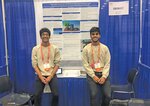


“Minnesota may not have a State Science Fair or State Science Bowls going forward. We just lost a 25-year sponsor who covered a third of our Science Fair budget. So now we’ve got six months to bring in new sponsors and close a nearly $200,000 budget gap if we’re going to save these programs and continue doing everything we’ve been doing.”
This is the message Minnesota Academy of Science (MAS) Executive Director Lara Maupin delivered to her staff, board, and members recently. “I believe we can do this but we’re going to have to work together and be creative,” Maupin told staff gathered in the Academy’s small office in the Midway (970 Raymond Ave.) to work on the organization’s 2024 budget. “We’ve got to get everyone who cares about science education in Minnesota invested in the challenge of saving these programs,” she added.
“We’ve offered a State Science Fair since 1950 and the State Science Bowls since 1994,” said Maupin. “We know how important these programs are for getting young people excited about science. They provide unique opportunities and they can actually change lives. These are experiences Minnesota kids aren’t going to get any other way.”
MAS remains one of the state’s oldest nonprofits, tracing its roots back 150 years to the formation of the Minnesota Academy of Natural Sciences in 1873 by 11 prominent Minnesota scientists led by renowned University of Minnesota geologist Newton Winchell. During its first few decades, the Academy sponsored lectures, published research, and supported scientific expeditions.
In the 1930s, a group of scientists and science teachers re-formed the Minnesota Academy of Science to promote wider interest in science throughout the state. The Academy brought isolated scientists together to share their research with fellow scientists and with teachers and interested members of the public. Since its incorporation as a nonprofit in 1937, MAS continued to promote science through publications, meetings, and student activities like Science Fair and Science Bowl.
Today, up to 500 middle and high school students advance to the State Science and Engineering Fair from Regional Fairs held across the state each winter. “We’re seeing Minnesota students tackle challenges they care about through their science projects, from diseases to everyday obstacles in their lives to environmental issues. We all need these kids solving community problems and getting encouragement from our working scientists,” said Maupin.
“Our Science Bowl teams are also amazing. These kids are practicing science and math on their own after school so they can do well in Science Bowl. They’re teaching each other and learning to work as a team. This is an incredibly successful program,” boasted Maupin. “Our state champs from Wayzata High School won the National Science Bowl in 2019 and just this year a brand new team formed by students from Minnetonka Middle School East and coached by a parent came in fourth in the nation.”
Despite the success of these long-standing statewide programs, both face critical revenue shortfalls as long-time sponsors end their support and program costs continue to rise. “A common misconception is that these programs are funded by the state. The truth is that less than 10 percent of our funding comes from the state and our legislative grant doesn’t get adjusted for inflation,” said Maupin. “So corporate, foundation, and individual donors are essential. But lots of companies and foundations have shifted their funding priorities in recent years away from programs like Science Fair and Science Bowl. Others are dealing with internal reorganizations or economic challenges that force them to stop sponsoring us.”
She added, “A lot has shifted during the pandemic and we are just starting to identify and adjust to these changes.We lost another major, longtime Science Fair sponsor just this week due to current economic conditions. Colleges that let us use their space for free for decades now say they have to charge us tens of thousands of dollars. School budgets changed during the pandemic. Teachers who brought kids to our programs left teaching. The generous investments we do have just can’t keep pace with rising costs and the need to give more support to educators and students. New donors have to step up if we’re going to keep these programs going in Minnesota.”
In contrast, MAS has seen support grow during the last few years for its newest program, Fostering Opportunities and Relationships in STEM Education (FORSE). “FORSE is an innovative program where we partner with schools and other community organizations to bring fun, hands-on science activities to students from groups that remain underrepresented in science, technology, engineering, and math (STEM) fields,” explained Maupin. “We’ve seen both our impact and our support grow rapidly. We’ve gone from serving 20 students to 3,000 in just five years.
“We’re grateful we get to help close the STEM opportunity gap in Minnesota through FORSE. It’s so important to show kids from all backgrounds that there’s a place for them in science. But I worry that if we lose Science Fair and Science Bowl, then those opportunities won’t be there for the elementary school kids we’re working with now in FORSE – and I worry we won’t have the scientists who are volunteering year after year for Science Bowl and Science Fair in our network if we cut back on or eliminate those programs. That’s a loss of potential mentors for our FORSE students, as well.”
“It’s hard to imagine becoming a scientist or an engineer if you’ve never met one,” said Maupin.
“I hope we can keep these doors open for all our kids in Minnesota. I urge anyone wanting to invest in the next generation of problem solvers to contact me directly or visit our website.”
To learn more and donate, visit www.mnmas.org.
Comments
No comments on this item Please log in to comment by clicking here